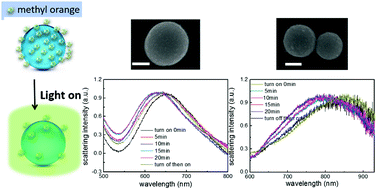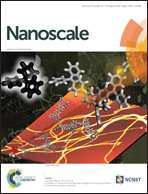Plasmon resonances in semiconductor materials for detecting photocatalysis at the single-particle level†
Abstract
Hot carriers, generated via the non-radiative decay of localized surface plasmon, can be utilized in photovoltaic and photocatalytic devices. In recent years, most studies have focused on conventional plasmon materials like Au and Ag. However, they suffer from several drawbacks like low energy of the generated hot carriers and a high charge-carrier recombination rate. To resolve these problems, here, we propose the plasmon resonances in heavily self-doped titanium oxide (TiO1.67) to realize effective hot carrier generation. Since the plasmon resonant energy of TiO1.67 nanoparticles (2.56 eV) is larger than the bandgap (2.15 eV), plasmon resonances through interband transition can realize both the generation and separation of hot carriers and bring a new strategy for visible-light photodegradation. The photodegradation rate for methyl orange was about 0.034 min−1. More importantly, the combination of plasmonic and catalytic properties makes it feasible to investigate the degradation process of different materials and different structures at the single particle level in situ. By detecting the scattering shift, we demonstrated that the TiO1.67 dimer (Δλ/ΔλRIU = 0.16) possesses a higher photodegradation rate than an individual nanoparticle (Δλ/ΔλRIU = 0.09). We hope this finding may be a beginning, paving the way toward the development of semiconductor plasmonic materials for new applications beyond noble metals.


 Please wait while we load your content...
Please wait while we load your content...